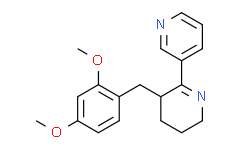| Cas No.: | 156223-05-1 |
| Chemical Name: | GTS-21 HCl |
| Synonyms: | 3-(2,4-Dimethoxybenzyl)-3,4,5,6-tetrahydro-2,3'-bipyridine;2,3'-Bipyridine,3-[(2,4-dimethoxyphenyl)methylene]-3,4,5,6-tetrahydro-, hydrochloride (1:2),(3...;2,3'-Bipyridine,3-[(2,4-dimethoxyphenyl)methylene]-3,4,5,6-tetrahydro-, hydrochloride (1:2),(3E)-;3-(2,4-Dimethoxy-benzyl)-3,4,5,6-tetrahydro-[2,3']bipyridinyl;3-(2,4-Dimethoxy-benzyl)-3,4,5,6-tetrahydro-[2,3']bipyridinyl Dihydrochloride;3-(2,4-dimethoxybenzylidene)anabaseine;GTS 21 dihydrochloride;3-(2,4)-DiMethoxybenzylidineanabaseine;3-[(3E)-3-[(2,4-dimethoxyphenyl)methylidene]-5,6-dihydro-4H-pyridin-2-yl]pyridine dihydrochloride;DMBX-anabaseine;DMXBA;DMXB-A;GS588;GTS-21 (DMXB-A);Ledipasvir;GTS 21;DMXB;GTS 21 2HCl;GTS 21 2hydrochloride;GTS-21 (hydrochloride);GTS-21 dihydrochloride |
| SMILES: | COC1=CC(OC)=CC=C1/C=C2CCCN=C\2C3=CC=CN=C3.Cl[H].Cl[H] |
| Formula: | C19H22Cl2N2O2 |
| M.Wt: | 381.3 |
| Sotrage: | 2 years -20°C Powder, 2 weeks 4°C in DMSO, 6 months -80°C in DMSO |
| Description: | GTS-21 dihydrochloride is a selective α7 nicotinic acetylcholine receptor agonist, has recently been established as a promising treatment for inflammation. Target: nAChRin vitro: GTS-21 is one of the most potent α7nAChR agonists, has been reported to attenuate pro-inflammatory cytokine production, improve outcomes in sepsis models, pancreatitis, and ischemia-reperfusion injury, and inhibit the production of endotoxin-induced TNF in lung tissue. In addition, recent studies have demonstrated that GTS-21 inhibits the activities of endothelial cells and monocyte macrophages, as well as the secretion of pro-inflammatory cytokines in peripheral blood samples, by regulating the JAK2-STAT3 pathway. [1] in vivo: In septic animals, GTS-21 significantly ameliorated GI motility, lowered systemic and colonic levels of IL-6, decreased colonic permeability, and decreased the number of positive cultures obtained from blood and mesenteric lymph nodes. Splenectomy prevented animals from developing sepsis-induced ileus. Chrna7 mice displayed a more severe septic phenotype, whereas GTS-21 remarkably was also beneficial in these animals. [2] |






















